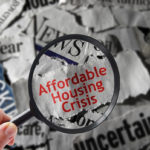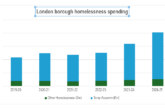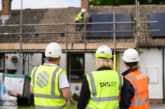LABM‘s Editor Claire Clutten discusses the housing affordability crisis, and why we need more social housing as well as affordable homes.
I received the latest research from the House Buyer Bureau in early July, which revealed that ‘the average homebuyer today requires 8.8 times their income to cover the cost of a home’.
Managing Director of House Buyer Bureau, Chris Hodgkinson says “you have to feel for today’s homebuyers who have seen house prices explode over the last decade or two,” while earnings have failed to keep pace. “As if this wasn’t bad enough,” adds Chris, “they’ve been further squeezed by high levels of inflation and the cost-of-living crisis in recent months and, as a result, are now paying through the teeth when looking to secure a mortgage due to interest rates hitting 5%.”
Housing affordability is a major problem across the country, particularly in areas such as the South-east. In May, I visited B3Living’s housing development in Cheshunt Lakeside, where they’ve delivered 195 new high specification homes for a mix of shared ownership and affordable rent. The housing association carried out purpose work with the local authority to understand the housing need in the area, and identified a high demand for one- and two-bedroom homes.
I spoke to Jon Hayden, Executive Director (Development) at B3Living, who told me that to buy a home in the Broxbourne area people need 12 times their salary to be able to afford it, which is crazy. How is that right or even sustainable…?
Originally, the Cheshunt Lakeside development’s affordable homes quota was just 10% (through Section 106), due to the developer needing to deliver a new school and a significant amount of infrastructure on site. Through B3Living’s involvement in the project that figure has more than doubled, thanks to the construction of 195 new affordable apartments.
B3Living wanted to provide a more affordable route into home ownership for local people currently priced out of the housing market and created 83 properties for shared ownership, in addition to the 112 for affordable rent. This is a great example of housing associations working hard to deliver on local need. You can find out more about this ambitious project on page 11 of our July/August issue.
We don’t just need more affordable homes however, we need more social housing too, and sector bodies like the National Housing Federation are at the forefront of championing this call. The NHF launched its ‘Why we need a long-term plan for housing’ report in June, highlighting that ‘there are 8.5 million people in England who can’t access the housing they need’ and for ‘4.2 million people, a social rent home is the right answer’.
Access to good quality genuinely affordable homes shouldn’t be a pipe dream, it should be a reality. As the NHF points out: ‘A decent, affordable home is as essential as having clean air to breathe, and should be a right for us all, wherever we live across the country’. The impact of a lack of housing and decent housing on people’s health and wellbeing is all too evident, and the knock-on effect to the NHS is significant, as the NHF’s recent report highlights — ‘poor quality housing costs the NHS £1.4bn each year’.
What determines a Decent Home? The Decent Homes Standard is currently undergoing a review with a view to a introducing a ‘Decent Homes Standard 2’, and as Matthew Warburton, Policy Advisor at the Association for Retained Council Housing (ARCH) writes in his Industry Comment for LABM on page 10 of our July/August issue: “There can be no denying that the DHS is in need of updating; the current version dates from 2006 and contains several features that now seem difficult to defend.”
Let’s hope the Decent Homes Standard’s new incarnation when it’s finalised is much more ambitious, as striving for ‘reasonable’ is not an aspirational or acceptable performance target.
Header image ©zimmytws/AdobeStock










